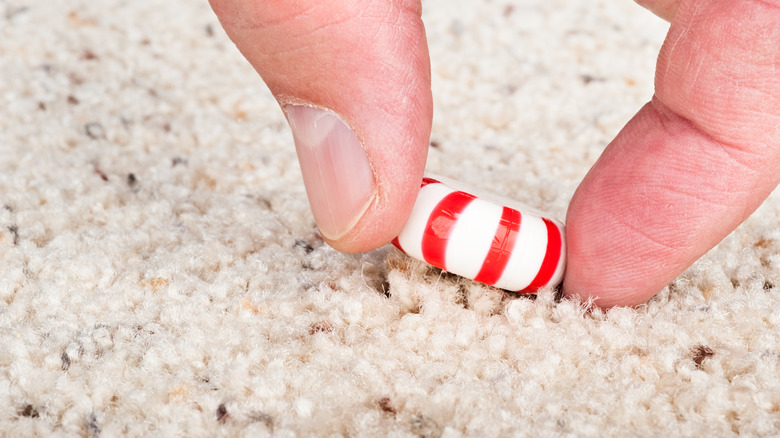Ghenghis Khan Is Responsible For The 5-Second Rule
Everyone's a little clumsy sometimes, and if you've ever dropped food on the floor, you've probably thought of the five-second rule. It's a nigh-universal concept — a law that is ingrained in us from our playground days, watching classmates fumble their lunch. Many of us have continued to ascribe to the five-second rule into our adulthoods, and at this point, it's become a piece of folk wisdom. But it really shouldn't be. Multiple studies have debunked the five-second rule, so how did we become so convinced of it?
Food scientists Paul Dawson and Brian Sheldon explored the origin of the five-second rule in their book "Did You Just Eat That?," tracing the aphorism to, of all people, Ghengis Khan. It is said that the Mongol ruler imposed a rule at banquets that any piece of food dropped on the floor could remain there as long as the Khan allowed and still be edible. Food for the Khan was of such quality that it would always be good, it was thought. However, some versions of the story suggest that people who followed the rule and subsequently died of food poisoning were said to have been "Khanned".
This is a far more lenient law than the five-second rule, but Khan ruled in the early 13th century, and germ theory would not be discovered for another 600 or so years. Of course, that would not stop us from nibbling scraps off the floor, and believe it or not, the term "five-second rule" came about over a century after we learned about germs.
The history of the five-second rule
The five-second rule wouldn't be the first time Ghengis Khan influenced our eating habits — he also played a role in the history of burgers — but it's unclear if this adage really stems from him. The story is a bit muddled, with some versions saying that the Khan had a 12-hour rule and others saying it was indefinite.
Throughout history, variations of the five-second rule continued to pop up. It's said that when Michelangelo was painting the Sistine Chapel ceiling, there was a 25-minute rule because if food were dropped from the top of the scaffolding, it would take 25 minutes to climb all the way down and retrieve it. A couple of centuries later, during the American Revolution, a one-minute rule was imposed, mainly because any food left on the floor for longer than that would be swooped up by dogs.
The famed chef Julia Child would prove instrumental in developing the five-second rule. In an episode of her show, "The French Chef," Child fumbled a pancake flip, dropping some on the stovetop (but not on the floor, as inaccurate retellings of the story have claimed). She calmly flipped it back into the pan, assuring her audience that, "You can always pick it up, and if you're alone in the kitchen, who is going to see?" Unfortunately, when it comes to eating dropped food, being seen is the least of your worries.
Don't trust the five-second rule
Unfortunately, the five-second rule doesn't hold up to science. It was put to the test in 2003 by Jillian Clarke, a high school student working as a research apprentice at the University of Illinois. In an interview with NPR, Clarke explained that she dropped gummy bears and cookies onto floor tiles, checking them for bacteria after varying time intervals. She found that the foods became contaminated with microorganisms regardless of how long they spent on the floor.
Subsequent research has backed up Clarke's findings. A 2016 study published in Applied and Environmental Microbiology revealed that foods can be contaminated the moment they hit the floor, although the longer you leave it there, the more bacteria will accumulate. While studies caution against trusting the five-second rule, it is dependent on a few factors. The most important is the cleanliness of the floor the food was dropped on, so it's essential to keep a clean kitchen (not just the floors, but all the surfaces food might touch). Certain floor surfaces also appear more risky, with tile and wood typically causing more contamination than carpet. Several studies found that the drier the food, the less bacteria it picks up, because bacteria are transferred through water. Drop a cracker, and the five-second rule might be okay, but drop a piece of meat, and you'd best just throw it out.


